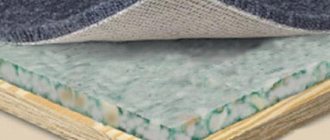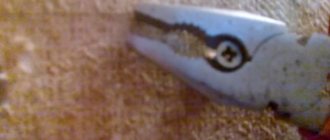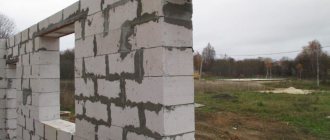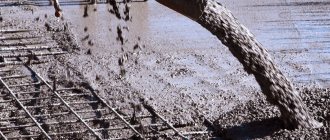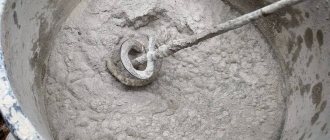Any craftsman knows that flooring is laid using a certain technology. For laminate or linoleum, stores sell related materials, the purpose of which does not raise questions for the buyer. But to the question: how to lay carpet, what technologies are available, not everyone can answer something definite. Despite the similarity with carpets, it is impossible to simply cover a floor, especially a concrete one. Carpet, just like other types of coverings, is laid using a certain technology using special accompanying materials.
How to properly lay carpet on a concrete floor
Carpet is an excellent sound-absorbing and heat-saving floor covering, which is a good option for a concrete floor. If you don’t know how to lay carpet on a concrete floor, then we can help you. This material will discuss in detail the installation process and all the nuances associated with it.
- Preparing to lay carpet on a concrete floor
- Underlay for carpet on concrete - is it necessary?
- Technology for laying carpet on a concrete floor
- How to lay carpet on a screed using double-sided tape
- How to glue carpet to concrete floor
- How to lay carpet on concrete using the stretching method
- How to properly lay carpet on concrete without fixing it to the floor
Wet cleaning
For wet cleaning, a special solution is used, which is whipped into foam and applied to the carpet. After this, the coating is vacuumed using a washing or regular vacuum cleaner. You can also do this manually. This method is only suitable for those coatings for which moisture is not contraindicated. For greater movement effect, it is better to carry out the movement crosswise. This type of cleaning should be done no more than once a week. To carry out wet cleaning effectively and safely for the carpet, you can invite specialists. They will not only do this according to all the rules, but will also treat your flooring with a protective antistatic layer.
Installation methods
When making a purchase, buyers often have a question: how to lay carpet. To do this, you can choose one of four methods. It all depends on the size of the room and the level of load.
Flooring without gluing
The least labor-intensive procedure is fixation with skirting boards. Relevant only for small residential or commercial premises with a flat, dry base.
First you need to carefully lay out the cut, align it and mark the cutting lines. The prepared carpet is removed.
Now you need to remove the baseboards, lay the covering on the floor and level it. The edges are folded, the coating is carefully rolled with a roller, swelling and creases are eliminated. The final touch is the installation of skirting boards.
Fastening with double-sided tape
It is used when you need to lay a single piece of carpet: glue tape to the floor along the perimeter of the room or in squares. A rolled carpet is laid against it, starting from the selected wall, with obligatory rolling with a heavy roller.
Substrate
The main difference between the technology of laying carpet on concrete and flooring on a rough wooden floor is the mandatory use of a backing.
For laying carpets on a concrete base, the following types of underlay are used:
- Polyurethane foam. Inexpensive and high-quality material that will smooth out unevenness and serve as additional hydro- and thermal insulation. Material thickness up to 6 mm. Polyurethane foam substrates are easy to install: they are sold in rolls. Simply unwind the lining and cut the strips to the required length. After this, the cut strips are removed, the base is coated with glue and the backing is rolled out onto the glue.
- Polyurethane. This type of substrate has a protective layer of polyethylene film. Due to this, the surface of the material is slippery, so they use stretched carpet for stretching. If you are using short-pile carpet, you can lay a polyurethane backing with a felt top.
- Made from pressed rubber crumbs. The base of this backing is made of polyjute. Of all materials it has the highest elasticity. Allows you to obtain a springy surface that is comfortable when walking.
Crumb backing
- Cork substrates are not used for laying on concrete, as additional work is required to waterproof the base.
The underlay for carpet on concrete is used for the following purposes:
- Compensating the load on the carpet, which will extend its service life.
- Creating a soft and comfortable coating.
- Reliable adhesion of carpet, eliminating shifting of the covering.
- Creating a barrier to the flow of cold air from the concrete base.
- Smoothing out uneven surfaces of the base.
Important! All types of carpet underlay are laid with glue.
Laying technology
When thinking about how to properly attach a substrate to a concrete base, you need to take into account the type of material and operating conditions of the room. You can attach the backing with double-sided construction tape or glue. Stretching technology is also used; it is possible to lay the flooring freely, pressing the material with skirting boards around the perimeter.
Laying on tape
This technology is very simple to implement, makes it possible to carry out work quickly, and, if necessary, easily and quickly dismantle the coating. The base must be clean and dry before starting work.
- Scotch tape is glued exclusively in the form of a continuous strip.
- On the concrete floor you need to form a grid with tape with a cell size of 50 by 50 centimeters.
- The protective layer of tape is removed as the carpet roll is rolled out.
- The carpet is rolled out, starting from the far wall, moving towards the exit, the material is smoothed and pressed, trying to achieve maximum fixation.
- The excess covering is cut off, then the baseboards are installed.
Bonding technology
It is possible to glue the substrate to various compositions, but their choice must be approached very responsibly. Not all adhesive bases are suitable for concrete monoliths. Just as not every glue is suitable for the selected type of substrate. It is advisable to follow the advice of professionals, read the instructions on the packaging of the adhesive (there, among the materials with which the adhesive can be used should be the one from which the backing is made).
Dispersion adhesives
The most common glue from this group is PVA, but it is better not to use it for a concrete base. Acrylic-based dispersive universal adhesives are much more suitable for completing the task. A distinctive feature of this type of composition is that the substrate must be glued to them immediately after applying the glue.
Two-component reactive adhesives
There is a special polyurethane adhesive used for laying underlayment on concrete floors. The glue includes two components: the adhesive itself and the hardener, mixed right before work (the carpet must already be rolled out). Initial setting occurs in about an hour, during which installation defects can be seen and eliminated.
- Setting occurs due to a chemical reaction between the two components, but not due to the evaporation of the solvent. The process occurs regardless of the temperature/humidity in the room and does not involve toxic fumes after completion of work.
- After hardening, the material becomes elastic.
- The glue can be used if there are minor defects in the base, which it eliminates.
It must be remembered that the hardener is toxic until the glue dries, so during the work it is advisable to constantly ventilate the room, and after that there is no need to be afraid. This type of adhesive is suitable for laying underlay or carpet directly onto concrete.
- The fabric to be laid is rolled out on the base, a rough (primary) trim of the material is made, extending onto the wall by about 7 centimeters.
- They lay the coating in two stages: first they work on one half of the room, then on the other. The already rolled material is lifted and folded in half.
- Using a notched trowel, coat the exposed half of the concrete floor with glue, being careful not to make the layer too thick, since then the glue may protrude along the edges and add problems.
- Maintain a certain time (specified in the instructions), unroll the raised half of the covering, carefully fix it with pressure on the floor using a rubber roller. You need to roll in the direction of the center/wall, do not press too hard.
- Do the same with the other half of the room.
Methods for fixing linoleum
The roll covering is attached to the floor in three ways:
Dry method - used in rooms with a small area (no more than 20 m2) - provided that a single piece is used. Linoleum is secured with skirting boards around the perimeter of the walls and a threshold strip in the doorway.
Advice: when fixing the roll covering in this way, you need to remember that modern plastic skirting boards are not able to reliably press linoleum to the floor due to their flexibility. Therefore, with the dry method, it is better to give preference to classic wooden skirting boards, which will reliably press the material along the entire perimeter (provided that the subfloor is well leveled).
- Gluing linoleum with double-sided construction tape is justified if the joining line of flooring fragments is straight and the room has little traffic. The method is attractive due to its ease and speed of installation. The disadvantage is the short service life of such fastening: over time, the sticky base of the adhesive tape dries out and loses its properties, and at the junction points the edges begin to curl up.
- Fixation with glue (mastic) is the most labor-intensive and expensive method. Partial fasteners (joints) and full fasteners (entire area of the canvas) are used.
What to glue carpet on
Lay the carpet on the concrete floor at a room temperature of at least +15 degrees. The coating should be laid out in the room a day before installation work to allow it to level and acclimatize.
To work you will need the following tools:
- a construction knife or an ordinary, well-sharpened knife;
- dense roller;
- screwdrivers for mounting skirting boards;
- spatula for gluing work.
To glue the coating to a concrete base, you need to purchase the appropriate adhesive. Typically polyurethane glue is used. Reaction and universal glue are also suitable for this purpose.
Two-component
To fix carpet, two-component polyurethane-based adhesives are often used. The hardener is added to this composition immediately before use.
The main feature of two-component adhesives is high adhesion. For this reason, they are ideal for attaching carpet to walls or uneven surfaces.
Advantages:
- moisture does not affect the adhesive properties, as well as the speed and degree of hardening, this is explained by the fact that drying occurs due to a chemical reaction and not evaporation of water;
- compositions are resistant to temperature changes;
- when frozen, they retain elasticity;
- When adding special additives, carpet installation work is allowed to be done at low temperatures.
Two-component polyurethane-based adhesives set within 60 minutes, so there is hardly enough time to correct an error made during installation.
Flaws:
- toxicity of the hardener, as a result of which it is necessary to ensure good ventilation of the room during work and compliance with safety precautions is required;
- the finished mixture must be used within an hour;
- It will be extremely difficult to remove the coating later, and in order to remove the remaining composition, you will need a sander.
The cost of some brands of two-component glue:
- KIILTO ECO 2 K-PU - 1.6 thousand rubles for 6 (5.45) kg;
- Thomsit R 710 - 4.5 thousand rubles per 10 kg;
- Eurocol FORBO 144 - 2.5 thousand rubles per 8 kg.
Do you need underlay for carpet?
This question worries almost every owner of the premises in which renovations are being carried out. If, when laying parquet or laminate, underlay material is used without fail, then with carpet, not everything is so simple. The use of a stabilizing layer can be abandoned in cases where the installation of the coating is carried out in a room where there is very low traffic, there is no need to additionally insulate the base.
However, professionals insist on compliance with the installation technology, and still recommend not to neglect the substrate, regardless of the type of roll material and the nature of its base. It will allow:
- extend the life of the carpet;
- increase comfort, due to which the floor will become softer and more pleasant to the touch;
- increase hygroscopic properties, heat and sound insulation, delay drafts emanating from the concrete base;
- hide uneven subfloors.
Today, manufacturers offer us a wide range of all kinds of underlays for carpet on concrete floors. But how to choose the right product without making a mistake? It is necessary to study the features of a particular material and, based on the data obtained, make a decision about purchasing a product. There are several types of substrates on the market:
- polyurethane foam. This option is perfect not only for an apartment, but also for offices, hotels and other public spaces. Withstands heavy loads, has high thermal and waterproofing properties, it can be mounted on bases with minor defects;
- polyurethane. They are used if the carpet is installed using the stretching method. Such substrates increase the thermal insulation of the floor several times and are insensitive to moisture;
- rubber. They are the hardest and most reliable of all existing substrate materials, characterized by a long service life (at least 20 years), withstand sudden temperature changes and various types of mechanical stress;
- cork They are safe from an environmental point of view, do not rot, and serve as a good thermal and sound insulator. The product allows you to hide small irregularities; it is often used for installation in children's rooms, because keeps the room warm.
The shock-absorbing layer must be elastic, but at the same time springy. You can check this parameter by crumpling the material in your hand. If the product immediately loses its shape, then you have a low-quality product that you should refuse to purchase.
Laying carpet with glue
First you need to make sure that the adhesive is compatible with the coating. Some compounds may react with carpet. Therefore, for a concrete base it is better to choose acrylic-based dispersion substances or two-component reaction products. The installation algorithm is simple:
- roll out the canvas around the room;
- place one part of the material on top of the other, thereby folding the carpet in half;
- coat the freed surface with a thin layer of glue, using a notched trowel;
- leave the product for 5-10 minutes;
- place the previously bent part on the floor, level the surface;
- do the same with the second half of the canvas.
Please note that the covering must be laid in such a way that its edges near the walls have a slight allowance. The thing is that after drying the canvas will shrink slightly in size, the remaining excess can be carefully trimmed. Well, in order for the material to acclimatize, it is better to keep it indoors for 24 hours.
The working process
Now step-by-step instructions on how to glue linoleum to concrete:
Before starting work, preparatory manipulations should be performed: the base under the linoleum must be cleared of debris and foreign objects. We remove the baseboards. (See also the article Insulation for concrete: features.)
- We cut out the resting linoleum with a construction knife with replaceable blades, leaving an allowance of 5-6 cm, and lay it out on the finished base.
- Open the container with glue and mix well. Thick compositions, for uniform and economical distribution, are applied to the base using a notched trowel, liquid ones - with a wide spatula with a smooth edge or a large rectangular brush.
- The glue is applied in the chosen order, first under one bent part of the panel, straighten the linoleum well, removing air bubbles from under it. The direction of movement is from the middle to the edges.
Please note that the drying time for different types of glue varies.
- Remove excess glue using a soft cloth.
- For the glue to set completely, you need to wait about 10 days and not create sudden temperature changes.
This figure describes the entire process that you will have to carry out when laying linoleum with your own hands.
When working with adhesives, be sure to use personal protective equipment, including for vision and breathing. (See also the article Leveling a concrete floor: features.)
How to properly prepare the base for carpet
Like all floor coverings, carpet requires a level, durable, hard and dry base. Stains of oil, old paint and mastic should be removed.
It is advisable to pre-level the base:
- Concrete - using a cement-sand screed, self-leveling subfloors or a gypsum-based leveler. It is allowed to grind the concrete or apply a quick-drying filling putty mixture.
- Wooden - by sanding, eliminating defects using wood putty. All weak elements must be secured with self-tapping screws. Ideally, form a new subfloor from sheets of plywood, chipboard or OSB.
Before laying, the base is thoroughly cleaned using a construction vacuum cleaner and primed with deep penetration impregnation.
After this, you can decide how to lay the carpet: without gluing (fixed with baseboards), with glue or tape.
How to lay carpet using adhesive methods?
Spread the carpet on a cleaned and dry base. Unscrew and apply glue. Coat the strip, as on wallpaper, leave it to dry for 7-10 minutes, roll it with a roller and glue it. Trim off the excess and fix it with plinths.
Glueless installation method developed in England. Requires special skills and the use of many additional tools - grippers, stretchers and staplers. Not suitable for rooms wider than 5 meters. Without experience, it is unlikely that this work will be done. But carpet laid using stretching will serve you faithfully for many years. Dismantling is simple.
Underlay for carpet on concrete - is it necessary?
If when laying carpet on a wooden floor or other base, laying the underlay is not necessary, then in the case of a concrete surface, its use is highly desirable. The underlay will make the floor softer, extend the life of the carpet, and protect the material from moisture that will come from the concrete.
Read the detailed article about carpet underlay.
It is better to secure the underlay material with glue, since it will also hold the carpet, and for this the backing should be secured as securely as possible.
Preparatory work
First of all, you need to carefully measure the area of the room where the carpet will be laid out. In this way, you can determine the required quantity for purchase, so that there is no unpleasant surprise if some 5-10 cm is not enough. It is advisable to purchase it in one piece.
Note! If the floor has an irregular shape, then carpet should be purchased according to the maximum width and length of the floor. And it’s better to do this with some reserve.
High-quality installation is only possible with careful preparation of the base. The floor surface must be dry, clean and fairly level. It is necessary to treat with chlorine to prevent the formation of fungus. Compared to laminate, carpet does not need a very flat surface.
If there are small depressions in the concrete, they should be removed using putty.
Important! The bumps protruding above the surface must be trimmed off, and then the concrete surface should be treated with a deep-penetrating primer. This is done to prevent the formation of dust, because it can break through the base of the carpet.
If there are significant unevennesses, then a self-leveling floor or some other self-leveling mixture is used.
Choosing a base for installing carpet
Laying carpet on a wooden floor
Before laying carpet on a wooden floor, you need to check what condition it is in. Floorboards are most often nailed, which over time begin to stick out and complicate repair work. Before laying the carpet on a wooden floor, the heads of the nails need to be driven in so that they go under the surface of the board, and after that the boards themselves can be sanded, eliminating possible unevenness.
You can also sheathe the floor with sheets of plywood specifically for carpeting. It hides numerous surface irregularities and defects very well. The plywood base will be smooth and even, so then laying carpet on it will not be difficult at all.
Laying carpet on a concrete floor
To make it easier to understand how to properly lay carpet on a concrete floor, you need to divide all the work into several stages:
- The base is prepared - large cracks are sealed, and if there is a significant difference in heights, a leveling cement-sand or self-leveling screed is made.
- When the screed is dry, debris and dust are removed from it, and its surface is treated with a primer.
- Carpet can be laid on concrete using the floating method or glued with special glue.
In this case, it is not recommended to use double-sided tape, since adhesion, despite the primer, may not be sufficient.
Sometimes laying carpet directly on a concrete floor is acceptable, but it is preferable to lay an underlay first. If the carpet has a textile base, then soft backings are suitable for it: based on rubber, polyurethane foam or felt. If the carpet has a rubber base, then a paper backing will be required.
Properties of natural and synthetic fabric
The backing consists of latex or jute and its substitute. The pile is made from natural or artificial wool, as well as polymers - nylon, polypropylene and polyester. The properties depend mainly on its composition.
Durability depends not only on the composition, but also on the structure of the pile. The shorter and thicker it is, the longer it will last. The length and thickness of the cover affects the ability to retain heat and absorb sound waves.
The material tolerates detergents and needs constant cleaning from dust that accumulates in the cover. It is not recommended for people with dust allergies.
The level of toxic substances in dyes, as a rule, is no higher than that of ordinary linoleum or laminate. In low-quality products it may exceed permissible standards.
Installation instructions for different substrates
The roll is cut upon purchase. It should be unrolled and allowed to rest for 24 hours until it finally straightens out. The choice of mounting method depends on the characteristics of the base.
Mount selection
- Thin nails - this old proven method has a number of disadvantages. The nails can gradually come out, causing a lot of discomfort. Small hats do not hold fabric well. The big ones are too noticeable. The problem can be solved by hiding them under the baseboard around the perimeter of the room. If you press them to the floor, they will not tear the edges. Nails are used to secure carpet to linoleum and wood surfaces. They are not suitable for concrete.
- Glue - polyurethane, water-dispersed or PVA. Water-dispersed compositions include acrylic adhesives.
- Double-sided tape - strips are attached in increments of 50-100 cm. The advantage of tape is the ability to quickly dismantle the coating.
- Gripper slats are baseboards that allow you to fix the fabric in a taut state.
- Without fastenings - the material is spread and pressed along the edges with skirting boards after straightening under the influence of its own weight. The main disadvantage of this method is the lack of fixation and tension. Loose fabric wrinkles and bunches. This method is not suitable for high traffic areas and large rooms.
Mounting method depending on the area of the room
- The area is no more than 12 m2 - it is enough to apply tape only around the perimeter.
- For an area of 12-20 m2, you need to apply it to the entire back surface in increments of 1 m. It is better to make a grid with cells of 50x50 cm.
- In large rooms it is better to use glue.
How to lay carpet on a wooden floor
The boards must be dry and clean. Protruding nails must be removed or hammered down. If the boards do not lie level, they are adjusted to the level and fixed so that there are no gaps between them. As a rule, installation is carried out on parquet or floor boards nailed to a timber frame. Laminate is used less often as it is usually removed and moved to another room, but old worn out laminate will serve as a backing.
Before carrying out work, remove the skirting boards, spread the canvas and let it rest. The length and width are taken with a margin, excess parts are cut off when stretching or straightening. To do this, use scissors or a sharp knife.
Before applying glue, the boards are primed. This is necessary to fill voids that impair adhesion to matter.
If you attach the canvas around the perimeter, it should be straightened from the center, dispersing folds and bumps. It is better to cover its entire area with glue. The spread sheet is folded in half, the free surface of the floor is coated, then the roll is lowered and the second part is treated in the same way. The overlap is 5 cm. Free edges in the middle are removed. The resulting edges are carefully coated and rolled with a roller. A grid with 50x50 cm cells is made from double-sided tape on the floor. The protective film is removed at the final stage of installation.
Before laying carpet using gripper slats, you need to measure their length and trim the sides evenly. The planks are nailed to the walls at an angle of 45 degrees. There are fasteners on their outer side that allow you to hold the fabric taut. It is inserted into the holders using special tools included in the gripper kit. The edges are folded and trimmed. The work requires certain skills. It will be difficult to stretch and press wide, long strips evenly. It is better to seek help from a repair and construction company.
How to install on concrete pavement
The peculiarity of the concrete coating is that it is not subject to deformation, so the fabric will not sag even under significant load. You can take less stock. 2-4 cm are added on each side.
All methods except nails are suitable for fastening. Most often, glue is used, which coats the entire surface, or double-sided tape.
Before laying carpet on a concrete floor, you need to prepare your tools.
Tools for work
- Knife or scissors.
- Wooden plank.
- Roulette and ruler.
- Roller for rolling joints.
- Notched trowel for applying the mixture to the surface.
Tools
During installation, you cannot do without a suitable set of tools, the list of which includes:
- Metal ruler . Ensures smooth cutting of material.
- Knife for cutting coating. Allows you to correctly cut the coating into strips or other shapes. It looks like a manual sewing machine, the handle of which is pulled, pressing the tool tightly against the surface. Recommended for inexperienced users.
- Lightweight roller blade . Suitable for experienced professionals - a novice master using such a tool can ruin the material.
- Video clip . Resembles a paint roller, but is wider and has a harder coating.
Depending on the installation method, additional tools may be used. If the coating is attached with glue, you should prepare a spatula or scraper to get rid of excess new or remnants of old adhesive. When laying with tension, you need a stretcher, with the help of which the edges of the material are pulled onto the slats.
